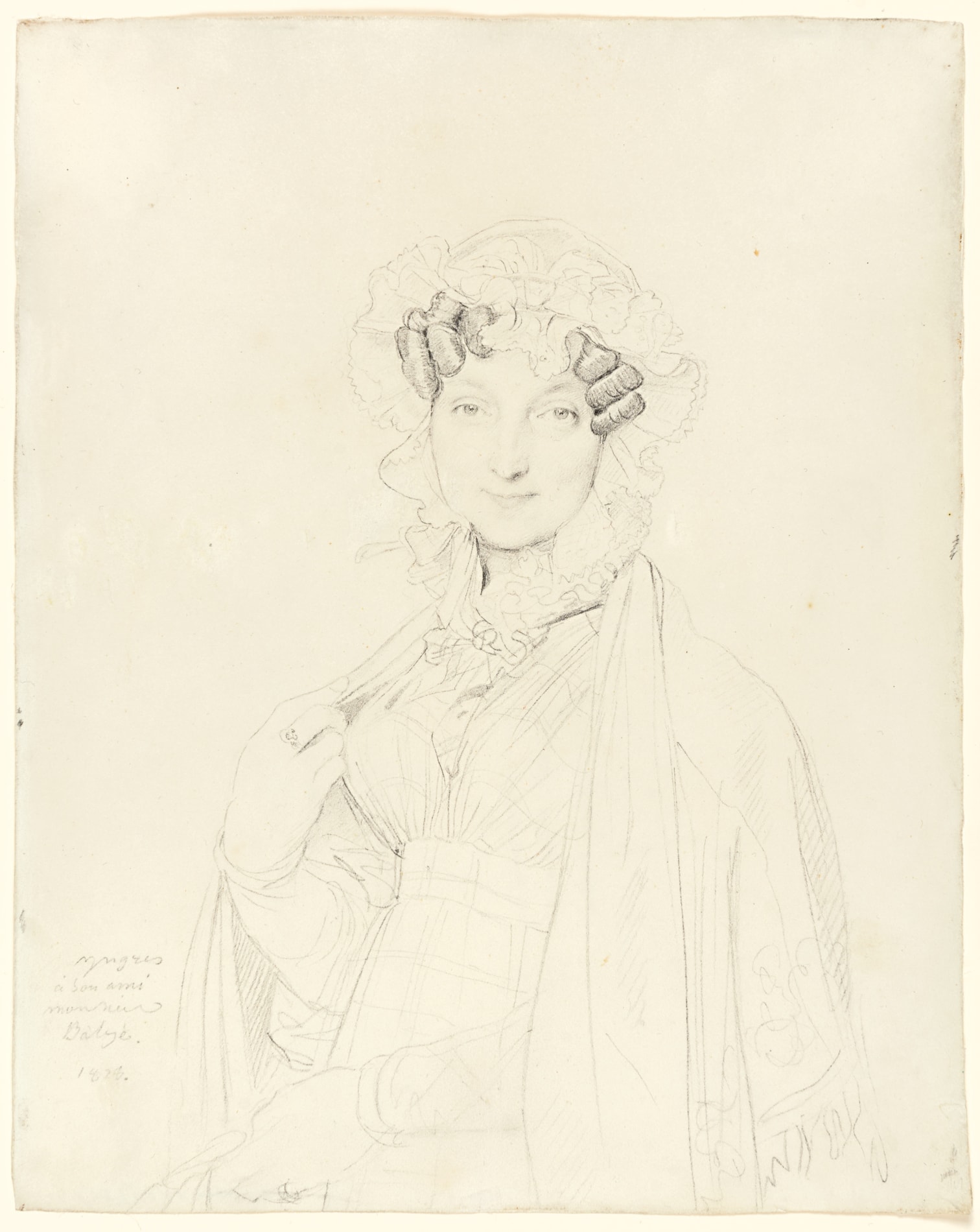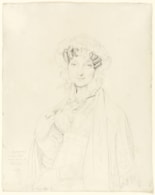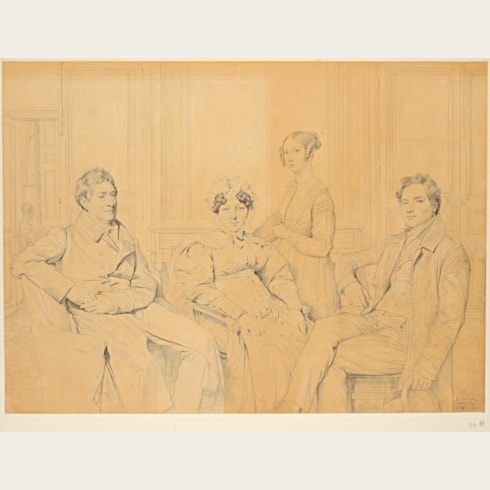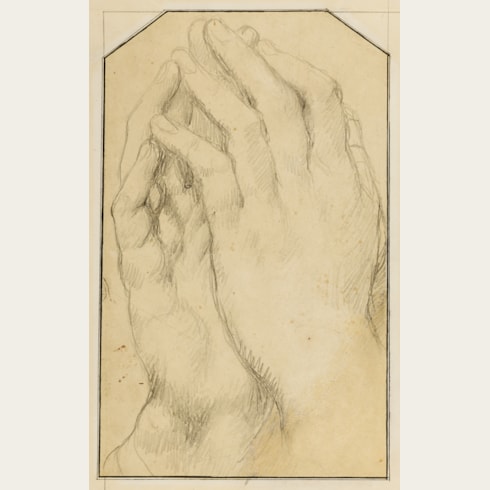Jean-Auguste-Dominique INGRES
(Montauban 1780 - Paris 1867)
Portrait of Marie-Anne-Adélaïde Balze, Mme. Joseph Balze
Signed, dated and dedicated Ingres / à son ami / monsieur / Balze. / 1828. at the lower left.
270 x 216 mm. (10 5/8 x 8 1/2 in.)
Drawn from life, over a period of not more than a few hours, Ingres’s portrait drawings may be counted among his finest and best-known works. Around 460 portrait drawings by Ingres are known today, most of which date from before 1824, when he left Italy and returned to France. Relatively few portrait drawings can be dated to the artist’s later Parisian years, of which the present sheet is a particularly fine example.
The sitter of this portrait drawing, Marie-Anne-Adélaïde Balze, née Samat (1783-1842/3), was the wife of Joseph Balze (1781-1847), who served as grand chamberlain to King Charles IV of Spain during his exile in Rome between 1811 and 1819. It was in Rome that Joseph Balze first met Ingres, from whom he commissioned some works around 1814. A lifelong friend of the artist, Balze continued to aid Ingres after his return to Paris from Rome in 1824, finding him several significant commissions.
This charming portrait of Mme. Balze was drawn in Paris in 1828, after the Balze family had returned to France. As Hans Naef has described the present sheet, ‘If one can recognize men by their wives, the portrait of Mme. Balze reflects the most beautiful light on her husband. The feminine charm of her posture and her features are evidently due not only to a favourable appearance, but also to the grace of her disposition.’ Two years after this drawing was made, the sitter’s young sons Paul (1815-1884) and Raymond (1818-1909) entered the studio of Ingres as pupils and assistants. They grew to be very close to the artist, who treated them almost like sons, often addressing them as ‘cher enfants’, even when they were grown men.
In the same year of 1828, Ingres also made a portrait drawing of Mme. Jean-Baptiste Hinard, née Marianne-Françoise-Stanislas Balze, the sister of Joseph Balze and sister-in-law of the present sitter, which is today in the Museum Boijmans Van Beuningen in Rotterdam. The portrait drawings of Mme. Balze and Mme. Hinard are very similar in attitude and execution and almost identical in size, and appear to have been executed as pendants. As one scholar, writing in 1911, noted of these two drawings, ‘[Ingres] made two lovely portraits in pencil for his friend, which are preserved like two treasures in the Balze family.’ Yet although Ingres produced splendid drawn portraits of the wife and sister of Joseph Balze, to whom he dedicated them, he never seems to have made one of Balze himself.
An autograph, traced version of the present sheet, drawn on papier calque, is in the collection of the Harvard University Art Museum in Cambridge, Massachusetts. As Agnes Mongan has noted, ‘it was not unusual for Ingres to make a tracing of a portrait of a close friend’, and the Fogg drawing seems to have been given by Mme. Balze in 1842 to her friend Mme. de Madrazo, the mother of another of Ingres’s pupils, the painter Federico de Madrazo.
Among closely comparable drawings of the same date is a portrait said to be of a Mme. Brazier, today in the collection of the Musée des Tissus et des Arts Décoratifs in Lyon. As has been noted by the costume historian Aileen Ribeiro, in his drawn portraits of women, who were usually depicted seated, ‘Ingres’s main concern…was with fashionable French dress, and particularly the freedom and scope offered by everyday costume, the kind of clothes in which his sitters could relax.’8 Referring to the present sheet in particular, Ribeiro has added that ‘it was probably natural that Ingres preferred to depict relatively simple styles of dress which could act as a foil to the face and headwear of his portrait drawings. Two portraits dated 1828, one believed to be of Madame Brazier and the other of Madame Joseph Balze, show sitters in modest day dresses. Madame Balze’s dress is a check fabric, fitting fairly tightly to the figure…Women of the most fashionable sort arranged their hair in sausage-like curls with a large bun on top of the head, known as an Apollo knot…Indoors, around the house, women wore caps of linen or cotton trimmed with lace and ribbons…The wonderful cream-puff confections that both Madame Brazier and Madame Balze wear on top of their prominent curls, serve to give the impression of heads rather too large for their accompanying bodies; this may reflect either Ingres’s concentration on the face and its immediate surroundings, or the particular attention devoted to hairstyles and headwear in the fashion plates of the period.’
The present sheet has been included in the folloiwng exhibitions:
Paris, Ecole des Beaux-Arts, Tableaux, Études peintes, dessins et croquis de J.-A.-D. Ingres, 1867, no.321
Paris, Palais des Beaux-Arts, Exposition Universelle Internationale de 1889: Exposition centennale de l’art français (1789 à 1889), 1889, no.330
Paris, Grand Palais, Exposition Internationale Universelle de 1900: Exposition centennale de l’art français, 1800 à 1889, 1900, no.1093
Paris, Galerie Georges Petit, Exposition Ingres, 1911, no.135
Paris, Chambre Syndicale de la Curiosité et des Beaux-Arts, Exposition Ingres, 1921, no.101
Paris, Galerie André Weil, Exposition Ingres: Maître du dessin français, 1949, no.59
Cincinnati, Cincinnati Art Museum, The Lehman Collection, 1959, no.274
London, The Lefevre Gallery, Important XIX and XX Century Works on Paper, 1977, no.21
New York, Jan Krugier Gallery, The Presence of Ingres: Important Works by Ingres, Chassériau, Degas, Picasso, Matisse and Balthus, 1988, no.27.
A student of Jacques-Louis David, Jean-Auguste-Dominique Ingres won the Prix de Rome in 1801, although due to a lack of government funding he was unable to take up his scholarship at the Académie de France in Rome until 1806. Although his pension expired in 1810, he remained in Rome for a further ten years. The city was at this time ruled by the French, and Ingres received commissions for paintings to decorate both the Villa Aldobrandini, the official residence of the French Lieutenant-Governor of Rome, and Napoleon’s palace at Monte Cavallo. He also found patrons among the French officials in the city, whose portraits he painted, as well as members of the royal court in Naples, led by Napoleon’s sister Caroline Murat and her husband Joachim, rulers of the Kingdom of the Two Sicilies. With the French withdrawal from Rome in March 1814 and the fall of Napoleon, however, Ingres found himself bereft of official commissions, and turned to making portrait drawings of French and foreign visitors to the city. These pencil portraits, drawn with minute detail as autonomous works of art, proved very popular and served to confirm Ingres’s reputation, allowing him to survive his difficult, penurious years in Rome.
In 1820 Ingres received a commission for a large canvas of The Vow of Louis XIII, intended for the cathedral of his native Montauban. Painted in Florence and sent to Paris to be exhibited at the Salon of 1824, it won Ingres considerable praise and established his reputation as a painter. He then spent a period of ten years in Paris, where he consolidated his reputation as a history painter and began receiving portrait commissions. This was followed in 1834 by an appointment as director of the Académie de France in Rome, Ingres remaining in the post until his final return to France in 1842. The last fifteen years of his career saw Ingres firmly established as an influential and highly respected figure in artistic circles, and one of the foremost artists in France. For many years an influential professor at the Ecole des Beaux-Arts, Ingres received the honour of a retrospective exhibition at the Exposition Universelle of 1855.
Provenance
By descent to his son, Paul Balze, Paris
By inheritance to his brother, Raymond Balze, Paris
By descent to his daughter, Anne-Marie Balze, Mme. Alfred-Pierre-Emile Hennet de Goutel-Balze
By descent to her daughter, Marguerite Hennet de Goutel, Mme. Jean Lacroix de Cariès de Senilhes
Otto Wertheimer, Paris, by 1956
Acquired from him by Robert Lehman, New York
Possibly the Fogg Art Museum, Cambridge, Massachusetts, in 1969 [on loan]
P. & D. Colnaghi, London
Galerie Kornfeld, Bern
Anonymous sale, Bern, Kornfeld & Klipstein, 9-10 June 1976, lot 437
The Lefevre Gallery, London, in 1977
Jan Krugier and Marie-Anne Poniatowski, Geneva
Their sale, London, Sotheby’s, 9 July 2014, lot 144
Bernd Schultz, Berlin.
Literature
Exhibition







